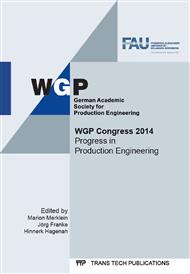p.293
p.301
p.309
p.317
p.325
p.333
p.341
p.351
p.357
Numerical Approach to Determine Natural Strain of Spherical Preforms in Open Die Upsetting
Abstract:
Many parts of today´s world are manufactured by cold forming operations or more precisely by mechanical upsetting such as wheelmounts or bevel gears because cold forming has several advantages compared to other machining operations. Due to size effects, the maximum achievable upset ratio in mechanical upsetting decreases with decreasing size of the work piece, so that upsetting becomes inefficient in micro range. Here, one promising approach is the laser rod end melting process generating a so called preform which allows upset ratios of several hundred within one stage. This preform is subsequently calibrated by a mechanical upsetting process. A numerical simulation showing the open die upsetting process of preforms, modeled with Abaqus, is presented in this work. Results of numerically determined natural strain are compared with an analytical model showing that the analytical model is a reasonable approximation. The maximum achievable average natural strain of preforms in upsetting is experimentally determined to be at least φ*=2.75.
Info:
Periodical:
Pages:
325-332
Citation:
Online since:
September 2014
Authors:
Keywords:
Price:
Сopyright:
© 2014 Trans Tech Publications Ltd. All Rights Reserved
Share:
Citation:


